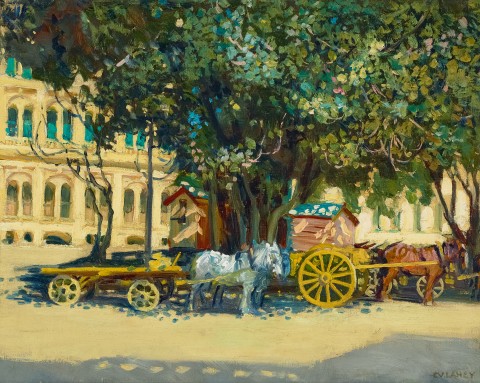(CARTS IN EAGLE STREET), c.1913
VIDA LAHEY
oil on board
39.5 x 49.5 cm
signed lower right: F. V LAHEY
Possibly: James Herbert Forrest, Charters Towers, Queensland
Thence by descent
The estate of Michael Forrest, Melbourne
E. J. Ainger Pty Ltd, Melbourne, 1 August 2021, lot 242 (as ‘European Street Scene with Horses’)
Company collection, Sydney
probably: Exhibition of Paintings, Empire Chambers, Brisbane, 13 – 18 October 1924, cat. 6 (as ‘The banyan trees, Eagle street’)
The Carter's Rest, Eagle Street, 1913, watercolour on paper, 33.0 x 42.0 cm, Exhibition of Paintings, Empire Chambers, Brisbane, 13 – 18 October 1924, cat. 12, in the collection of the Queensland Art Gallery/Gallery of Modern Art, Brisbane
The carter’s resting place, oil on board, 20.5 x 20.5 cm, Oil and Watercolours by Vida Lahey, Athenaeum Hall, Melbourne, 29 September – 10 October 1925, cat. 31, Private collection
At the junction of Creek and Eagle streets in Brisbane, a group of horse-drawn carts take shelter from the heat of the Queensland sun. Despite the suggested tranquility, this urban island, captured by Vida Lahey in (Carts in Eagle Street), c.1913, was only fifty metres from the bustling commercial hub of wharves and warehouses located on the banks of the Brisbane River. Here, ‘draymen and cabmen ... waited at the reserve for hire (as did) waterside workers who waited at ‘The Triangle’ each morning to be hired as day-labourers.’1 Visible at the centre of the composition are wooden sheds containing public urinals for the men’s convenience (later removed in the 1970s) and to the right, just out of view, was a water fountain set up for the horses and workers which survived at the site until the Second World War. At the rear is the ‘old’ Dalgetty Building (1883 – 84), and presiding over the whole scene is a majestic Banyan fig tree and two figs planted in the 1870s by Walter Hill, superintendent of the nearby City Botanic Gardens. Due to their prominence, it is possible that this work is actually The banyan trees, Eagle Street, exhibited in the artist’s solo exhibition in 1924.
Eagle Street was once Brisbane’s ‘most romantic street’, full of picturesque maritime personalities who populated the ‘shabby, friendly quays and lanes that debouch on the river.’2 In (Carts in Eagle Street), Vida Lahey set up her easel on The Triangle’s third boundary of Elizabeth Street, from which she also painted The carter’s rest, Eagle Street, 1913, now in the collection of the Queensland Art Gallery | Gallery of Modern Art.3 Initially trained at the Brisbane Central Technical College under Godfrey Rivers, Lahey moved to Melbourne in 1905 to study at the National Gallery Art School under Frederick McCubbin and Bernard Hall. She attracted public notice two years later when she was awarded first prize for still life in the landmark First Australian Exhibition of Women’s Work held at the Royal Exhibition Building in 1907. She subsequently returned to Brisbane and by the time she painted (Carts in Eagle Street), Lahey was already noted for her empathetic portrayal of workers, both domestic and commercial, through such works as Monday morning, 1912, a powerful portrait of two women laboring in her family’s laundry. Gifted that same year to the Queensland Art Gallery, this life-size painting quickly became one of the most popular works in the collection. However, little of Lahey’s output prior to these years survives due to a fire which burnt her studio down in 1912 with all her paintings.4
As such, (Carts in Eagle Street) marks a renewal of practice for the artist. During the Great War, she based herself in London, and studied further in England and France. On her return, Lahey was peripatetic for some years with periods in Hobart, Melbourne and Sydney before finally re-settling in Brisbane in 1929. She would return to painting images of the rapidly changing city, particularly for a solo exhibition in 1932 (see lot. 7), but the number of surviving pre-war works that have survived is few. Inevitably, the drowsy ambience of this scene is long gone, overtaken by the increasing use of motor-driven transport which eventually supplanted the ranks of horse-drawn carts. Today, only the heritage-listed Banyan tree and its White Fig companions remain.
1. East, J. W., ‘The lost heritage of Eagle Street: a case study of the commercial architecture of Brisbane 1860-1930, 2019, p.16 at www.espace.library.uq.edu.au/data/UQ_733239 (viewed 17.09.21)
2. ‘Growing City. Romance and Adventure: Street of Adventure’, Courier-Mail, Brisbane, 26 September 1933, p.12
3. The carter’s rest, Eagle Street is incorrectly described on the Queensland Art Gallery’s website as being on the corner of Eagle and Queen’s streets, which is approximately 100 metres further north and features the Moonie Memorial fountain (extant).
4. See Lloyd Rees, 1988, cited in MacAulay, B, Songs of Colour: The art of Vida Lahey, exhibition catalogue, Queensland Art Gallery, Brisbane, 1989, p.38
ANDREW GAYNOR
